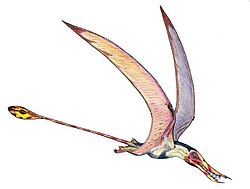Top Qs
Timeline
Chat
Perspective
Kimmeridge Clay
Geological formation in England From Wikipedia, the free encyclopedia
Remove ads
The Kimmeridge Clay is a sedimentary deposit of fossiliferous marine clay which is of Late Jurassic to lowermost Cretaceous age and occurs in southern and eastern England and in the North Sea.[1] This rock formation is the major source rock for North Sea oil. The fossil fauna of the Kimmeridge Clay includes turtles, crocodiles, sauropods, plesiosaurs, pliosaurs and ichthyosaurs, as well as a number of invertebrate species.
Remove ads
Description
This section needs expansion. You can help by adding to it. (May 2016) |
Kimmeridge Clay is named after the village of Kimmeridge on the Dorset coast of England, where it is well exposed and forms part of the Jurassic Coast World Heritage Site.[2] Onshore, it is of Late Jurassic (Kimmeridgian) age and outcrops across England, in a band stretching from Dorset in the south-west, north-east to North Yorkshire. Offshore, it extends into the Lower Cretaceous (Berriasian Stage) and it is found throughout the Southern, Central and Northern North Sea.[1]
The foundations of the Humber Bridge on the southern (Barton) side of the bridge are on Kimmeridge Clay beneath superficial deposits, under the Humber estuary.[3]
Remove ads
Economic importance
Kimmeridge Clay is of great economic importance,[2] being the major source rock for oil fields in the North Sea hydrocarbon province.[4] It has distinctive physical properties and log responses.[5]
Vertebrate fauna
Summarize
Perspective
Color key
|
Notes Uncertain or tentative taxa are in small text; |
Fauna uncovered from the Kimmeridge Clay include:[6]
Ray-finned fish
Lobe-finned fish
Cartilaginous fish
Turtles
Archosaurs
Thalattosuchians
Ornithischians
Indeterminate ankylosaur osteoderms have been found in Wiltshire, England.[19] Indeterminate stegosaurid remains have been found in Dorset and Wiltshire, England.[6]
Saurischians
Indeterminate ornithomimmid remains have been found in Dorset, England.[6] An undescribed theropod genus was found in Dorset.[6]
Pterosaurs
Plesiosaurs
Ichthyosaurs
Remove ads
Invertebrates

The invertebrate fauna of the Kimmeridge Clay includes:[37][38]
- Mollusca:
- Cardium striatulum
- Ostrea deltoidea
- Gryphaea (Exogyra) virgula
- Trigonellites
- Belemnotheutis
- Etchesia
- Arthropoda:
- Phlyctosoma sp.
- Eryma sp.
- Magila latimana
- Mecochirus sp.
- Archaeolepas redtenbacheri
See also
References
Further reading
Wikiwand - on
Seamless Wikipedia browsing. On steroids.
Remove ads




















